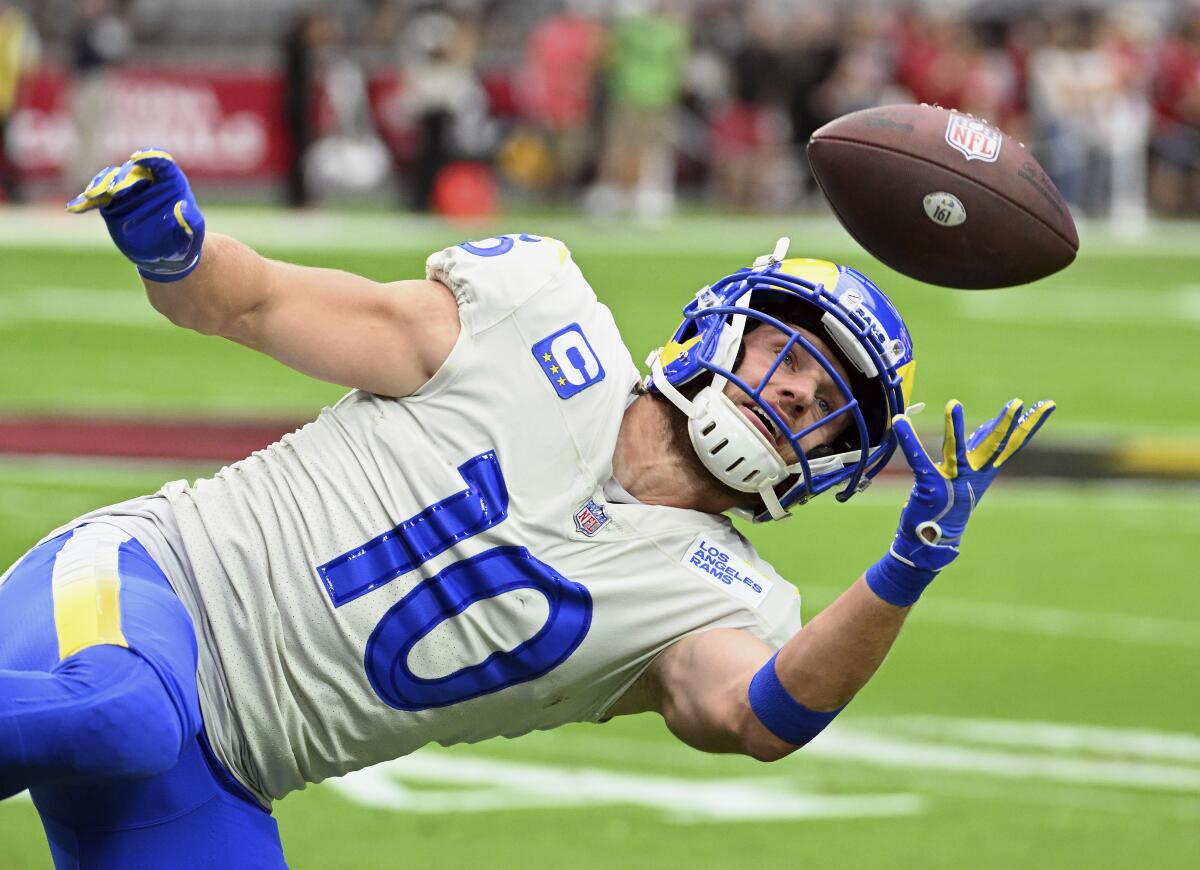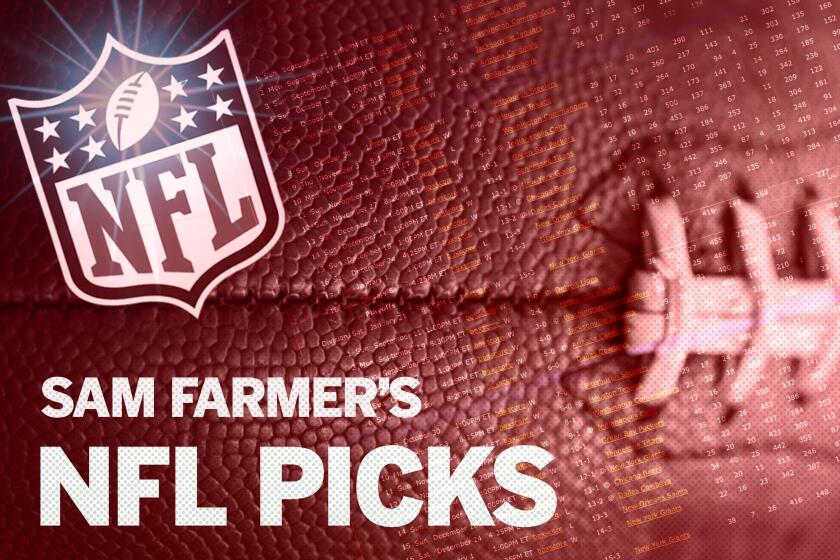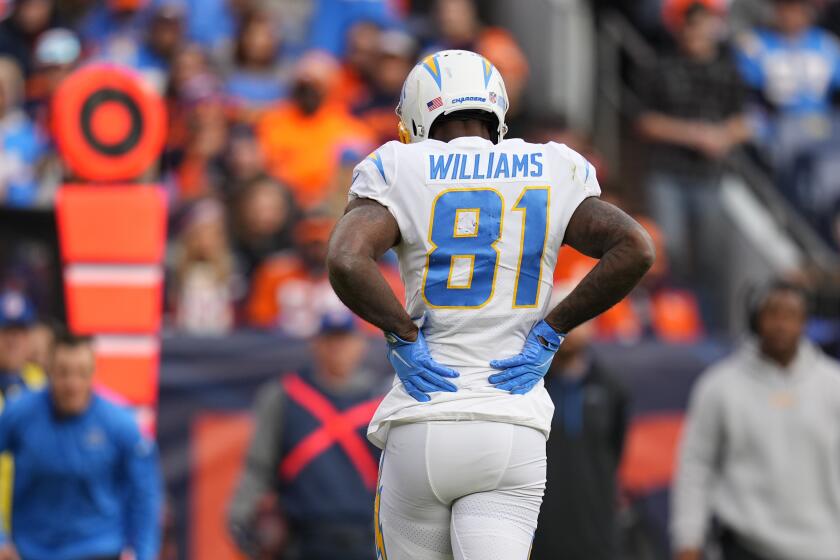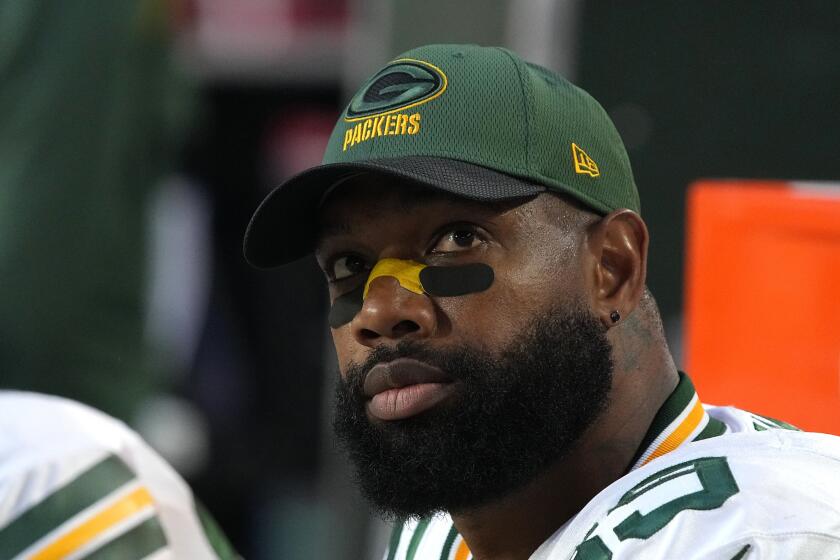Rams’ Cooper Kupp gets it: UCLA study shows he wears a performance-enhancing number

- Share via
It happened overnight. NFL wide receivers believed they had just gotten faster, slimmer and swaggier — if such a comparative adjective existed in 2004.
The reason wasn’t new undetectable PEDs.
Call them PENs: Performance-enhancing numbers.
No longer were wideouts restricted to wearing jersey numbers from 80 to 89; numbers from 10 to 19 were permissible as well. Look good, feel good, play good. That’s the mantra for wide receivers, a group long known for their vainglory.
Receivers had long held that numbers beginning with a 8 made them appear fat, giving new meaning to the term wideout. Besides, anything to do with the 80s was old school. Teens are perpetually cool.
And now there’s proof, or at least an academic study — from UCLA, no less — that validates what wide receivers have said all along. The findings were published Thursday in PLOS ONE, a peer-reviewed open access mega journal published by the Public Library of Science since 2006.
Sam Farmer makes his picks and predictions for Week 1 of the 2023 NFL season, starting with the rising Lions getting on the big stage against the champion Chiefs.
In two experiments, subjects consistently said that images of players in jerseys numbered from 10 to 19 looked thinner than those in jerseys numbered from 80 to 89, even when the body sizes were the same. The finding suggests that associations between numbers and sizes experienced over time influence the perception of body size.
“How we perceive the world is highly influenced by our prior knowledge,” said Ladan Shams, a UCLA professor of psychology and neuroscience and the paper’s senior author. “In our daily lives, numbers written on objects — on a bag of sugar in the supermarket or weights in the gym — usually represent the magnitude of the objects. The higher the number, the bigger or more massive the object generally is.
“Previous research has established that our brains are very good at detecting and storing statistical associations and regularities, unbeknown to us, and those associations can shape future perception.”
The NFL might have intuitively surmised as much when in 1979 hulking defensive linemen were allowed to wear numbers from 90 to 99. And it turns out those self-absorbed wide receivers were right all along. By 2019, long before the issue had become an accepted topic of academic study, the migration to lower numbers occurred, with ESPN determining that 79.4% of receivers in its player database wore numbers 10 to 19.
The Rams and Chargers were among the leaders. When the Los Angeles teams begin the 2023 season Sunday, only Mike Williams of the Chargers among wideouts will wear an 80s number. Cooper Kupp wears 10. Keenan Allen wears 13. And so on.
Many observers were upset when Mike Williams was hurt in a meaningless game before a playoff loss to Jacksonville, but the Chargers star receiver defended the move.
Williams wore No. 7 at Clemson, but single-digit numbers were outlawed until 2021 for all NFL players except quarterbacks, punters and kickers. The Chargers first-round pick in 2017 went with No. 81 because that’s what his idol, Calvin Johnson, wore for the Detroit Lions.
Many players have a personal reason for the number they wear, and it’s likely more important in football than most other sports. Heads are concealed by helmets, numbers are large and often provide the best clue to their identity.
Another Johnson — Keyshawn — was an indisputable pioneer in recognizing that his number was more than a number. The No. 1 overall draft pick out of USC in 1996 concocted a plan, waiting to inform his new New York Jets team the number he preferred until all 80s numbers were taken by teammates.
He slipped through the loophole, chose No. 19 and the NFL approved the exception. Johnson was savvy enough to understand branding.
“I wasn’t just a unique talent, but a unique personality that could capture the fan base and have fans gravitate toward, you know, me,” Johnson told ESPN in 2019. “When you saw No. 19, you automatically knew what that stood for and why it was that way.
“It was all about looking cool and different, and being someone that people could identify with. When you see a green No. 19 jersey, who is the first person you think of?”
From Long Beach Poly to UCLA to an 18th NFL season, no tight end has played longer than respected locker-room leader Marcedes Lewis of the Bears.
Players fans probably think of first wearing numbers in the 80s are tight ends. Besides Williams, Rams and Chargers donning jerseys with 80s numbers are exclusively tight ends, for whom looking slim isn’t the top priority.
Grabbing a number from 10 to 19 is becoming a preference for more than wide receivers. Once the singular domain of quarterbacks and kickers, starting in 2021 those numbers could be worn by running backs, defensive backs ... even linebackers. Few of those numbers are available because receivers scooped them up years ago. But when one becomes free because of a trade or retirement, it can be as coveted as a corner office at a law firm.
Another popular number is a big fat 0, available this season for the first time. Twenty-two players have opted for it, including linebackers Byron Young of the Rams and Daiyan Henley of the Chargers.
One would think the untold thousands of NFL fans who attend games or watch from home while wearing jerseys of their heroes would opt for numbers that make them appear faster, slimmer and swaggier. Not so. The only wide receiver whose jersey is in the top 10 in sales is the Dallas Cowboys’ CeeDee Lamb.
His number? 88.
More to Read
Go beyond the scoreboard
Get the latest on L.A.'s teams in the daily Sports Report newsletter.
You may occasionally receive promotional content from the Los Angeles Times.














